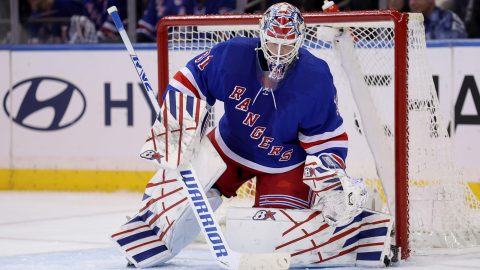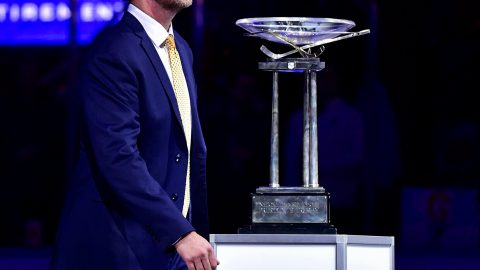As fantasy drafts gear up for the beginning of the season April 4, keep in mind that drafting is a strategy.
Like all other strategies, there are certain things that, if followed, will give you a successful draft.
If you adhere to the three keys below, you'll find yourself with a team near the top of the pecking order.
1. Put on your nerd glasses.
OK, you don't need the glasses, but you do need to know what some advanced statistics are, because they can only help.
What if I told you there was a stat out there that was just like ERA — but better? That the statistic is a better predictive model than ERA? After all, many people use ERA to judge how good a pitcher is. If there's a better one out there, shouldn't it be used?
Good thing you're reading this then, because I have such a statistic for you. It's called FIP and it stands for Fielding Independent Pitching. Even better, it's scaled to ERA to help with context.
"Is that an advanced statistic?!," you cry. Yes, it is.
Lost in all this debate about "advanced statistics" is that you don't
have to do the math. You just have to know what it means. Do you
know how to calculate ERA? You don't have to,
but you can still know what it means. The same applies for
advanced statistics. Your fantasy baseball competitors might ask you
where your pocket calculator is, but you'll get the last laugh when you
hoist that coveted fantasy trophy.
To help explain FIP, let's look at a case study. Last year, Jason Bay and Jacoby Ellsbury patrolled left and center field, respectively. Without getting into the arguments on who is good on defense and why, it's clear that the new arrangement of Ellsbury in left and Mike Cameron in center will get to more balls than the 2009 outfield version.
Why should someone like Josh Beckett be penalized or rewarded for actions completely up to the fielder? If Jason Bay isn't be able to get to a screaming line drive in the gap but Ellsbury would pull off a highlight-reel catch, the pitcher benefits: his ERA is lower with Ellsbury in left.
Leaving statistics up to the vagaries of whether or not a pitcher has a good defense behind him isn't very smart. After all, defenses can be improved, as Boston did this offseason. If defense improves, a pitcher's ERA improves.
FIP helps look at what a pitcher actually did (home runs, walks, strikeouts), not what it appears he did.
Florida's Ricky Nolasco gets the most press due to his ERA-FIP differential, and for good reason. On the surface of things, Nolasco had a terrible 2009. His 5.06 ERA was much higher than his breakout 2008 campaign, when he posted a 3.52 ERA.
Guess what? Throw everything out of Nolasco's control out the window, and he pitched better in 2009. His FIP in 2008 was 3.77. In 2009? 3.35.
A big reason why his FIP in 2009 is so low and his ERA so high has to do with batting average on balls in play — BABIP.
It has been historically studied and confirmed that balls hit in play normalize to around .300. Put a ball in play, and three out of 10 times, it'll fall for a hit.
Nolasco's BABIP in 2008 was .284, meaning he got lucky: less of his pitches fell for hits than should have. 2009 was an entirely different story, as his BABIP was .336. In aspects of pitching Nolasco personally controls — strikeouts, walks and home runs — he produced better in 2009.
If you normalize BABIP in both years to .300, you would get something around a 3.50 ERA, which is exactly how Nolasco should be valued in drafts — not his unsightly 5.06 ERA.
ERA can fluctuate from year to year, based on many different factors. However, when there is enough data over a player's career, a player's career ERA often always ends up being within percentage points of the career FIP, indicating that ERA does balance out over years of regression to the mean.
Important: Note that FIP and BABIP are two completely separate statistics. FIP does not account for BABIP in its calculation. How it works is that Nolasco pitched well (FIP) but was unlucky (ERA) because of factors beyond his control (BABIP). You can find FIP and BABIP on player pages at FanGraphs.com.
2. Know everyone is not equal — but some are.
Do yourself a favor: concede that some of your favorite players and targets in your fantasy draft will not be picked by you. You won't be able to get them all.
Once you prepare yourself for that, you won't overreact by saying "This player is gone, now I have to get this player or I'm up Charles River without a paddle!"
You can make your life much easier and have a much stronger draft by understanding that most players can be lumped into a group — and the idea is not to draft players, it's to draft one of the players in the group.
Let's apply this in practice.
Say that your personal top 10 rankings of third basemen look like this:
1. Alex Rodriguez, Yankees
2. David Wright, Mets
3. Evan Longoria, Rays
4. Mark Reynolds, Diamondbacks
5. Ryan Zimmerman, Nationals
6. Pablo Sandoval, Giants
7. Kevin Youkilis, Red Sox (he has first- and third-base eligibility, and is more valuable at third)
8. Aramis Ramirez, Cubs
9. Michael Young, Rangers
10. Adrian Beltre, Red Sox
If Rodriguez, Wright and Longoria go off the board before it's time for you to pick and you're panicking, does that mean you've got to draft Reynolds immediately? Absolutely not.
While there is a drop-off in value from the first three names to the rest of the third basemen, the drop-offs aren't linear. The value of the players No. 4 (Reynolds) through 9 (Young) is closer to each other than the difference between No. 3 Evan Longoria and Reynolds. If you miss out on Reynolds, the world isn't over. You can still draft someone with similar value all the way through Young.
By understanding this, you can focus on drafting the best value for the round and avoid pigeonholing yourself into one player.
That's not to say you shouldn't keep an eye on the pool of talent available. If your pick is up and Sandoval is the only player remaining in the top nine, you better take him because once you reach No. 10's Adrian Beltre, the talent takes another step down.
Important: Don't concern yourself with going through the top 50 players at every position and writing down your own grouping — unless you have the time or desire for that. In that case, have at it. For the more casual drafter, having a general idea is enough. Eyeball the players available per position and judge when you think the overall talent of players takes a step down. Those are your groupings. There are also plenty of fantasy baseball lists out there that do all the work for you.
3. Walk, don't run.
In near every fantasy draft, you can expect a run on a certain position to happen, whether in the first round or later.
It usually starts with someone drafting a certain player and others wanting to make sure they get the next best candidate at the position, so they start drafting that position all at once. (Those silly people didn't pay attention to No. 2 on this list.) Ten picks later, the position is depleted and the draft moves on.
Don't fall into this trap. Just because a certain position goes on a run doesn't mean you have to join in. Remember, it's a marathon, not a sprint. True in both baseball and in fantasy drafts.
Your goal every single round should be to get the best value for that round, just like every team's goal should be to get the best bang for the buck. Don't compromise.
To use the third basemen rankings above, if the first three picks go early and then someone drafts Zimmerman, beginning a run of third basemen coming off the board, don't join in unless you can get comparable value.
For example, if it's your turn to pick and seven of the last nine picks have been third basemen with only Aramis Ramirez remaining of the No. 4 through 9 third-base rankings, by all means, go get him.
However, if a run on third basemen leaves you staring at the top nine all gone and only in the third round, don't lower your sights and pick No. 10 Adrian Beltre — he is not comparable value to the previous subset. Get your third baseman when it's time.
While everyone else is focusing on getting a player who should be going in the 10th round, not the third, you'll be focusing on the ones that provide third-round value. So sure, you won't get a top-10 third baseman … but you might make up for it by snatching a top-five second baseman while everyone hurries to fill the third base spot and ends up losing value.
If a run leaves you with unsavory options at a certain position, look for those listed elsewhere that qualify at the position of need. Kevin Youkilis, for example, will play first base the majority of time for Boston. However, he retains third base eligibility, and there's nothing stopping you from playing him there in fantasy. If anything, Youkilis may have the most value in his subset because he can play first, which increases your flexibility.
Important: Keep an eye on those who are switching positions that don't have eligibility yet. For example, Gordon Beckham of the White Sox will be the team's starting second baseman. He doesn't have eligibility because he played third last year. He'll probably fall through the cracks of some drafts — but he'll get eligibility shortly (it depends on how many games are required to gain eligibility, and it varies in most fantasy leagues — certainly no longer than mid-April). He could be a top-five second baseman that people won't notice because he doesn't show up on the second base rankings. Don't shy away from selecting him just because he's listed at third base. It'll be worth it once he becomes eligible.
Hungry for more? Check out NESN.com's top
300 fantasy baseball players. See who's on the cusp of stardom in the top 15 breakout candidates, as well as players to stay away from in the top 15 regression candidates.
See our position-by-position rankings here: C
| 1B
| 2B
| 3B
| SS
| OF
| SP
| RP



